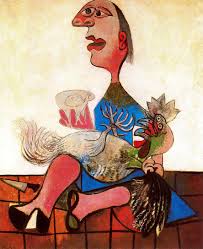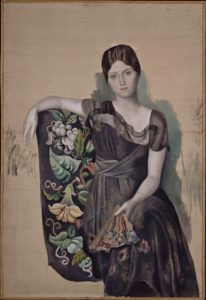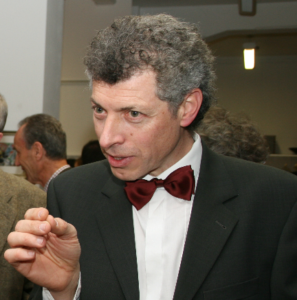Woman with Rooster
Oil on Canvas, Pablo Picasso –
Article by Professor Cristian Korn
Note about the article: The following article, written in Spanish by Professor Cristian Korn, was translated into English. We have intentionally preserved all its linguistic authenticity. Professor Korn, a multilingual artist, refers to his proficiency in the English language as “primitive” feeling more comfortable writing in Spanish. Professor Korn will continue to share his art knowledge with our Collectors via this section of our newsletter
“That’s horrible” said the boy in front of Picasso’s “Woman with Rooster”
He was referring to Woman with Rooster, painting in the permanent collection of the Staatsgalerie Stuttgart museum in Germany, a few days ago. Outside there was sun and people were walking unhurriedly and without sorrows.
The painting shows a human being (active element), a defenseless animal lying and a gun (passive elements) in pyramidal composition centered on a space barely suggested. The scene shows tension. This is therefore an imminent sacrifice.
“Woman with Rooster” was painted in February 1938 a few months from the “Guernica” (pictorial allegation of paramount importance in Picasso’s universe and first international guest in the international exhibition of Paris and later for decades in the MOMA in New York until its finally arrival to Spain in 1981). Picasso would have regretted having died without seeing the painting in his homeland.
Reading a work of art has various aspects of analysis.
In “Woman with Rooster,” biographic, social and plastic elements converge equally. Here are some ways of analyzing the work:
Picasso, during the second half of his thirties, suffers severe emotional conflicts based on his difficult separation from Olga Chochlova. At the same time was the development of its parallel relationship with Marie-Therese Walter mother of Maia, Picassos’ first daughter, and the emergence of Dora Maar in the artist’s love life.
Three women with unequal characteristics inspire Picasso also unequally:
Olga, of Russian background and a ballet dancer, had suggested for Picasso a neoclassical search.
Marie-Thérèse whose Nordic appearance, extremely young and lover of sports, would inspire elegant rounded shapes and rhythms.
Dora, finally, of Yugoslavian origin, an artist herself, known in the group of the Surrealists for her collages and photographs, was introduced to Picasso in 1936, the first year of the gruesome Spanish civil war.
From a historical perspective, today we see that the Spanish war as a preamble to World War II. Picasso at the time feels the fratricidal tear of his people as a fierce destruction, effectively fatal. The cruelty of those years in his country and his personal battles in search of emotional stability generates unprecedented distortions in the treatment of form in his art work
| Portrait d’Olga dans un fauteuil (Olga in an Armchair), 1918, Musée Picasso, Paris, France. Image from Wikipedia.com |
It is under these pressures that beautiful Dora’s face will be subjected to extreme deformations, viscerally uncomfortable contrasts and distortions of egregious size. These transformations reflect on Picasso’s internal and external passionate experiences lived of personal, emotional nature and, the individual, collective social tear, which reveal characters in roles and situations as open wounds.
In the painting “Women with Rooster,” we hesitate to say if the main character is truly a woman, especially recognizing the proximity of the face to a Picasso self-portrait of 1937. But it is clear that it should be a woman to liken the situation to a typical Michelangelo’s “Pieta”, in the Vatican collection, with his painful passion.
The rooster, which in the past has been a symbol of courage and beauty, and, a subject of numerous studies in the graphic work of Picasso of those years, comes with claws effectively strung and wings brutally handcuffed, a prisoner unable to escape.
Dirty and reddish soil announces blood and the character seems to raise her right hand, barely sketched, showing an empty glass.
Picasso accompanies the scene with different treatment in the oils, showing changes in strategy. There are ideas, frustration and struggle.
The Figure used to show more blue and more dress where now the stunned, writhing rooster foresees his fate. The background was completely repainted with masses of white where the blows of the spatula create a wall of tactile relief isolating all. We can also see scratches created with the paint brush. The black, severe, pathetical line encloses the figures. The formal resolution of the work, with the specific exception of color treatment is quite similar to that of the Guernica, the inhuman bombing in the Bascan City still remains fresh in memory.
Surely the boy’s comment of the painting was correct.


